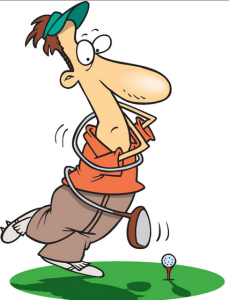Injuries in Golf
What is the most typical golf injury? It might not surprise you that lower back pain tops the list. Next, on the list, are problems with the wrists and shoulders. And what is worse, recreational golfers are more prone to these than the pros. Lower back pain will seriously hamper your enjoyment of the game. And may even keep you away from the course for long periods of time.
So, how can it be managed? And what can be done to minimise the risk? Let’s take a look.
The cause of this typical golf injury
Although the golf swing is a short duration and powerful movement, the majority of injuries are over-use injuries as opposed to acute injuries. In other words, it is the small mistakes that you make repeatedly that put you most at risk.
The low back problems often occur due to the unusual trajectory of a golf swing. The power is sent through the legs prior to the lower back simultaneously twisting and extending. This is a particularly unnatural movement.
Unfortunately, the lumbar region of the spine isn’t well designed for these combined forces. And the problem is exacerbated by the reduced flexibility that sitting at a desk most of the day induces. The attorneys for work-related injuries suggest that every player must avoid injuries while playing golf since every injuries in this field is quite fatal and takes ages to recover.
How to prevent lower back pain in golf
The key is to increase mobility and flexibility in that area. This includes decreasing tension in the areas close to the lower back such as the hips, glutes and the upper back. Deep tissue massage is definitely a good way to loosen up these areas.
It is also important to be thorough in your warm up when you get to the golf course. The warm-up should last at least 10 minutes and should include some easy swings of a 7-iron on the practice range to gradually increase range of motion.
Improving your swing to protect your back
These little tips are based on you being a right-handed player. Obviously, a left-hander needs to think these through in reverse.
- On the backswing, keep your right knee bent and turn your left shoulder downward.
- On the downswing incorporate a mini squat motion with your legs. This will help reduce torque on your spine
- On impact, the majority of your weight should be over your left leg (about 90%).
- At the completion of the swing allow the pelvis to thrust forward. And by the time you finish the swing, you should be at your normal standing height.
Of course, we understand that some of these actions are easier said than done. So invest in some coaching to see if you are putting these tips into practice. If you can get a session with video, it is well worth it. Seeing yourself in action gives you a much better idea of how contorted your body can get.
A final word
There is only so much you can do on the golf course. To protect your lower back consider some supplementary exercise. If you are not a gym bunny, why not try Yoga or Pilates. These are both increasingly popular for strengthening the core and improving flexibility.
We hope this information is useful for you. If you need advice or have any questions about our treatments, please contact us. You can find us in Mill Hill Broadway and Islington. We are always happy to help. If you like this blog, please share!




